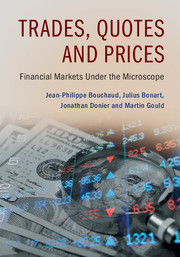Book contents
- Frontmatter
- Dedication
- Contents
- Preface
- Acknowledgements
- PART I HOW AND WHY DO PRICES MOVE?
- PART II LIMIT ORDER BOOKS: INTRODUCTION
- PART III LIMIT ORDER BOOKS: MODELS
- PART IV CLUSTERING AND CORRELATIONS
- PART V PRICE IMPACT
- PART VI MARKET DYNAMICS AT THE MICRO-SCALE
- PART VII ADVERSE SELECTION AND LIQUIDITY PROVISION
- PART VIII MARKET DYNAMICS AT THE MESO-SCALE
- PART IX PRACTICAL CONSEQUENCES
- Appendix
- Index
PART VIII - MARKET DYNAMICS AT THE MESO-SCALE
Published online by Cambridge University Press: 26 February 2018
- Frontmatter
- Dedication
- Contents
- Preface
- Acknowledgements
- PART I HOW AND WHY DO PRICES MOVE?
- PART II LIMIT ORDER BOOKS: INTRODUCTION
- PART III LIMIT ORDER BOOKS: MODELS
- PART IV CLUSTERING AND CORRELATIONS
- PART V PRICE IMPACT
- PART VI MARKET DYNAMICS AT THE MICRO-SCALE
- PART VII ADVERSE SELECTION AND LIQUIDITY PROVISION
- PART VIII MARKET DYNAMICS AT THE MESO-SCALE
- PART IX PRACTICAL CONSEQUENCES
- Appendix
- Index
Summary
Introduction
At this point in our journey into financial markets, we have discussed a large number of major empirical facts, developed microscopic models of the LOB, and proposed several different paths for explaining impact. We have also seen how statistical models of order flow can capture some intricacies of the price-formation process, and how economic models can shed light on some of the effects induced by strategic behaviour. However, none of the tools or approaches that we have considered so far can properly account for a crucial empirical fact: the square-root impact of traded volumes on prices. This suggests that a piece of the puzzle is still missing.
The square-root impact law has been found in many different markets, with completely different micro-structural organisations. This suggests that the explanation should not be sought within the strict framework of an LOB, but relies on a more general – perhaps more fundamental – underlying mechanism.
In this part, we will introduce a very general framework designed for understanding the behaviour of supply and demand in a complex and dynamic environment. At the core of this approach lies the following observation, which has arisen at many points throughout the book: the liquidity shortage common to all markets suggests that the visible LOB is only the tip of the iceberg, beneath which lies a large amount of latent liquidity. In the coming chapters, we will argue that understanding and modelling directly this latent liquidity is key for understanding how markets behave – and how best to act in them.
The starting point of this discussion will be the free evolution of supply and demand: how do they behave, irrespective of any transactions that might occur, and thus also of the clearing mechanism in place? To address this question, we will introduce a model that provides insight into the vanishing nature of liquidity around the market price. In contrast to the models that we have studied so far, this model successfully reproduces the square-root law of impact, while still resembling the propagator models that we have discussed in the previous parts.
Of the puzzles that we evoked at the beginning of this book, many answers may now be found. The flat signature plot can be explained by the actions of market participants seeking arbitrage opportunities, irrespective of the question of market efficiency.
- Type
- Chapter
- Information
- Trades, Quotes and PricesFinancial Markets Under the Microscope, pp. 333 - 336Publisher: Cambridge University PressPrint publication year: 2018



